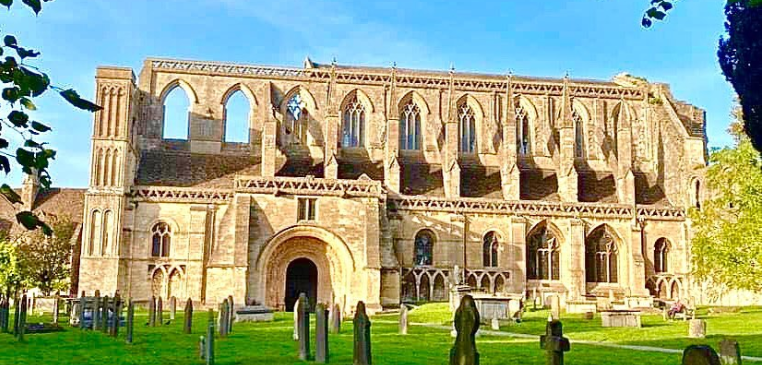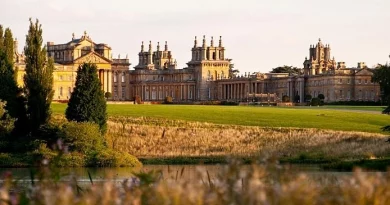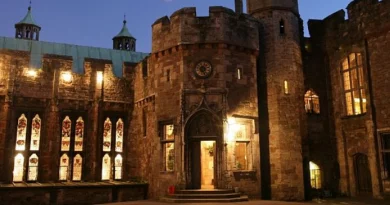Cotswolds Trivia – Churches and Religion
Malmesbury Abbey was the site of an early attempt at human flight when in 1010, the monk Eilmer of Malmesbury flew a primitive hang glider from a tower. Eilmer flew over 200 yards (180m) before landing, breaking both legs.
Prinknash Abbey, a monastery near Painswick, was established as long ago as the 11th Century. In 1096 the Giffard family, who came to England with William the Conqueror, made a gift of the land to Serlo, Abbot of St Peter’s, Gloucester.
The Church of the Holy Cross in the village of Avening, near Tetbury, is thought to be the only church commissioned by a Queen of England, following a royal scandal more than 900 years ago.
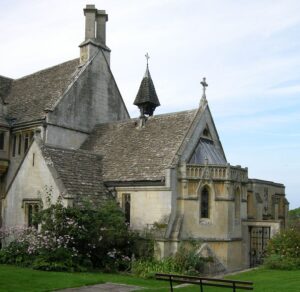
Brittric, a young Saxon nobleman who lived at what is now Avening Court, was sent on a mission to Baldwin, Count of Flanders, and there he met Matilda, who later became the wife of William the Conqueror. Matilda apparently fell in love with Brittic, but he refused her. When she became the Queen of England, Matilda remembered this slight and trumped up a charge against him. Brittic was thrown into Worcester Prison where he died. Matilda, in remorse, ordered the rebuilding of Avening Church (formerly a Saxon church) so that prayers could be said for the repose of his soul. The church was dedicated on Holy Cross Day, September 14, 1080, and it is said that on that day the Queen provided a feast for the builders of a boar’s head. Now in alternate years the feast continues to be celebrated in Avening on “Pig Face Day” when parishioners take the roles of Queen Matilda and other dignitaries.
St John Baptist Church,Cirencester, is the largest parish church in Gloucestershire and its 162ft (49m) high tower is the tallest in the county.
Church tours are available throughout the year and on special days the tower is open to visitors who are prepared to climb the narrow steps to the top in order to enjoy a panoramic view over the town.
Villagers in Bisley, near Stroud, appeared to have a knack for upsetting church authorities centuries ago. In the 13th Century, Bisley was placed under interdict by the Pope after the local priest fell into an uncovered well in the churchyard and drowned.
In the 15th Century there was a brawl in Bisley churchyard and blood was shed, and once more the parish was placed under papal interdict. One consequence was that the people of Bisley were not allowed to bury their dead anywhere within the Diocese of Worcester for a period.
The closest place outside the diocese which would accept Bisley burials was at Bibury, so the people of Bisley had to carry their dead 15 miles to be buried there. Over time the section of Bibury’s churchyard where the Bisley dead were interred became known as “The Bisley Piece”.
All Saints Church in Bisley has a unique hexagonal “Poor Soul’s Light” in the churchyard. This 13th Century structure was used to hold mass candles for those who could not afford candles of their own, and it is the only outdoor example in the country.
The tower of Holy Trinity Church,Minchinhampton has an unusual truncated spire because the original spire proved too heavy for its supporting arches.
In 1563 the spire was taken down halfway and finished with a coronet which gives it so unusual an appearance.
The tower of St Edward’s Church, Stow-on-the-Wold, is 88ft high and houses the highest peal of bells in Gloucestershire.
The north door of the church is flanked by a pair of ancient yew trees which butt up directly to the porch and have been described as “resembling the lower legs and feet of a giant chicken”.
A redundant Anglican church in a Cotswold village which had a chequered history was at one time used as a cow shed for a number of years.
St Mary’s Church in the small hamlet of Shipton Solers (alternative spellings Shipton Sollars, and Shipton Solars) near Andoversford, dates back to the late13th Century and, according to historical records, it was a gift of William de Solers in 1298.
But by the 17th Century the fabric of the building had decayed and the church was closed.
In 1883 when Rev Charles Pugh was appointed rector, the church was at that time being used as a cow shed. Its windows were blocked and trees were growing through its roof.
With the help of his wife, the rector repaired the church and reopened it the following year. Services were held during the summer months but the condition of the church deteriorated again and the services were discontinued.
In 1929 the church was repaired again and it continued to be used occasionally during the 20th Century.
However, it was declared redundant in 2005 and the Grade I listed building is now under the care of the Churches Conservation Trust.
The east window of St Michael’s Church, Buckland, near Broadway, contains some splendid 15th Century glass, considered to be among the nicest in the Cotswolds and reputed to have come from nearby Hailes Abbey at the Dissolution of the Monasteries.
The parish church was a favourite of William Morris, a leading member of the Arts and Crafts Movement, who attended church services at Buckland in the 19th Century and who was so impressed by the glass that he personally paid for its releading.
Roberts House in Siddington, near Cirencester, was once the home of John Roberts, one of the founders of the Quaker movement, who lived in the Cotswold village in the 17th Century.
Nearby stands a cottage and in its gardens lie the remains of a graveyard, the last resting place of John Roberts and several other Quakers.
The parish church of St Mary the Virgin, Wotton-under-Edge contains the Berkeley Tomb which features what are said to be the best brasses of their kind in England.
The church’s 18th Century organ, built for King George I, came from St Martins-in-the-Fields in London and was reputedly first played by the famous composer Handel.
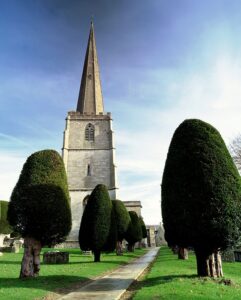
A sizeable Huguenot community made their home in Stroud in the 17th Century, fleeing persecution in Catholic France.
They were followed by a significant Jewish presence in the 19th Century, linked to the town’s tailoring and cloth industries.
George Whitefield, the Gloucester-born evangelist and one of the founders of Methodism, is said to have preached to over 10,000 people from the top of a Neolitic long barrow on Minchinhampton Common in 1743. The earthwork is now called Whitefield’s Tump.
The carved Norman font in St Peter’s Church, Southrop, near Fairford, is said to be one of the finest in England.
The tub-shaped baptismal font was discovered by Rev John Keble built into the south doorway of the church in the 1820s.
The font features a series of five fascinating figures, each representing a virtue triumphing over a vice, with the virtues depicted as trampling the vices underfoot.
A bell ringers’ society was formed at St Mary’s Church, Painswick, in 1686 and the ringers are still known as the “Ancient Society of Painswick Youths”.
As the longest running society in Painswick, members still ring the church bells regularly for the main Sunday services and for weddings and other special occasions and practise on Tuesday evenings.
St Mary’s is most famous for its churchyard with its well-tended yew trees, but legend has it that there are only ever 99 yew trees as the Devil always kills the hundredth.
The church has been surrounded by colonnades of yews since they were put there in 1792.
On the nearest Sunday to September 19, the ceremony known as “clypping the church” takes place when local children wear flowers in their hair, join hands and embrace the church.
The First World War screen in St Mary’s Church is a Roll of Honour carved by a Belgian refugee which lists all those from the village who served in the Great War and the names of those who died in gold.
Elizabeth Cross was one of a group of 19th Century Dissenters who took up residence in the neighbouring Cotswold villages of Duntisbourne Abbots and Duntisbourne Leer.
Later, with her husband, she set up a mission school on the Pacific island of Tonga which was responsible for the conversion to Christianity of the King and Queen of Tonga. The Tongan royal family have remained Methodists ever since.
The church of St Peter & St Paul, Blockley contains a series of handsome monuments to local landowners and some interesting brass monuments dedicated to former parish priests.
In the 1950s, Canon Henry Cheales, rector of St Lawrence Church, Wyck Rissington, built a maze between the rectory and the church to symbolise the Christian path through life.
Canon Cheales, who was rector of the parish from 1947-1980, built the maze in the garden of the rectory, where it was used as a tool for spiritual growth.
On every St Lawrence Day (August 10) Canon Cheales and his parishioners walked the maze and paused at each of 15 waymarked stations for prayer.
When the rectory was sold after Cheales’s death, the maze was dismantled, but a tile copy of the maze design is set upon the wall of the north aisle, where you can find an informational sheet explaining the symbolism of the maze and the different stations sited along the paths that lead through it.

